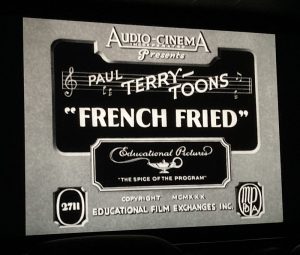 I begin today with an aside, providing to readers as a public service a detailed description of a “find” which had its world re-premiere in a newly-restored print at UCLA’s Preservation Festival last Saturday. The title is the elusive first Farmer Al Falfa short produced at the official Terrytoons studio, French Fried (1930), a pre-code item too hot for the CBS censors to handle. The film seemed to get the liveliest audience reaction of anything on the bill this year, with Fleischer’s Hold It ranking number 2 (although several other Fleischer color entries, and a charming Van Beuren Rainbow Parade, remained eye-openers for visual spectacle instead of aiming for belly laughs). As the film ties in with the subject of airships, as a means of transporting Farmer Al as a tourist-on-the-loose to Paris (though it could equally fit within the pages of my prior series discussing cartoons using vacuum cleaners), I have posted my description as a supplemental blog to my past article, “Flights of Fancy (Part 2): More First Contacts”, which (at current time) may be located on this by clicking HERE and scroll the comments to the bottom. (Also feel free to check out any past installments of prior article series which you might have missed!)
I begin today with an aside, providing to readers as a public service a detailed description of a “find” which had its world re-premiere in a newly-restored print at UCLA’s Preservation Festival last Saturday. The title is the elusive first Farmer Al Falfa short produced at the official Terrytoons studio, French Fried (1930), a pre-code item too hot for the CBS censors to handle. The film seemed to get the liveliest audience reaction of anything on the bill this year, with Fleischer’s Hold It ranking number 2 (although several other Fleischer color entries, and a charming Van Beuren Rainbow Parade, remained eye-openers for visual spectacle instead of aiming for belly laughs). As the film ties in with the subject of airships, as a means of transporting Farmer Al as a tourist-on-the-loose to Paris (though it could equally fit within the pages of my prior series discussing cartoons using vacuum cleaners), I have posted my description as a supplemental blog to my past article, “Flights of Fancy (Part 2): More First Contacts”, which (at current time) may be located on this by clicking HERE and scroll the comments to the bottom. (Also feel free to check out any past installments of prior article series which you might have missed!)

We’ll look today at the waning days of the theatrical short, as circus stories continue to make sporadic appearances here and there. (Please note: Due to indistinguishable animation quality between Hanna-Barbera’s theatrical Loopy De Loop shorts and their standard television product, I will delay discussion of the Loopy series until overall coverage of the studio’s output in a later article.) Featured are numerous one-shots (including one where Paramount finally gets things right), some lively action by Heckle and Jeckle and Woody Woodpecker, a Tom and Jerry reminiscent of Warner Brothers, and a comparison of two works of Alex Lovy, spaced a decade apart for competing studios.
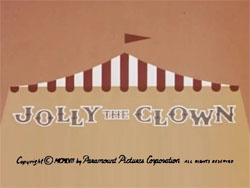 Jolly the Clown (Paramount/Famous, Noveltoon, 10/25/57 – Seymour Kneitel, dir.) – A fun and lively venture by the studio into its new cost-cutting period of stylized animation, attempting to capitalize upon the rising popularity of the work of UPA. In this one, the character designs remain still quite appealing, and much of the animation continues to be quite fluid, though backgrounds are largely minimalistic with solid colors and geometric patterning for floodlights. Our title character is the star performer of the circus (talking only in squeaks that resemble the traditional voice of the star puppet of a Punch and Judy show), with a fairly-clever act of his own, entering in a clown car that couldn’t rightfully hold any driver larger than Herman the Mouse, yet unfolding from the driver’s seat before the audience’s eyes. He sets up a sales table as a street hawker, and demonstrates a hair-growing formula upin his bald dome (which sprouts a large flower from his scalp instead). Cutaways to the audience reaction present the interesting touch of everyone laughing uproariously, except for one bespectacled man in the center, who just sits stoically. (Could this have been an in-joke depicting someone at the studio who had no sense of humor? As Jiminy Cricket once said, “Oh, well, you can’t please everybody.”) A pair of keystone cop clowns enter in pursuit of Jolly’s unlicensed sales pitch, and Jolly retreats to his miniature car, then extends hos full size feet through its floorboards, to run for a hasty exit out the circus tent. The crowd cheers again, and the show moves on to its next act – little Ellsworth Elephant, whose act consists of balancing atop a rolling barrel across the arena, up onto a teeterboard. Unfortunately, this is not his day for gracefulness. As he attempts to balance the barrel at the center point of the teeterboard above the fulcrum, he slips, landing off to one side of the board, while his barrel lands on the opposite end. Ellsworth’s weight catapults the barrel into the air – right onto the head of the ringmaster. The flustered boss utters the dreaded words, “You’re fired!” to Ellsworth, and the poor elephant leaves the tent in disgrace.
Jolly the Clown (Paramount/Famous, Noveltoon, 10/25/57 – Seymour Kneitel, dir.) – A fun and lively venture by the studio into its new cost-cutting period of stylized animation, attempting to capitalize upon the rising popularity of the work of UPA. In this one, the character designs remain still quite appealing, and much of the animation continues to be quite fluid, though backgrounds are largely minimalistic with solid colors and geometric patterning for floodlights. Our title character is the star performer of the circus (talking only in squeaks that resemble the traditional voice of the star puppet of a Punch and Judy show), with a fairly-clever act of his own, entering in a clown car that couldn’t rightfully hold any driver larger than Herman the Mouse, yet unfolding from the driver’s seat before the audience’s eyes. He sets up a sales table as a street hawker, and demonstrates a hair-growing formula upin his bald dome (which sprouts a large flower from his scalp instead). Cutaways to the audience reaction present the interesting touch of everyone laughing uproariously, except for one bespectacled man in the center, who just sits stoically. (Could this have been an in-joke depicting someone at the studio who had no sense of humor? As Jiminy Cricket once said, “Oh, well, you can’t please everybody.”) A pair of keystone cop clowns enter in pursuit of Jolly’s unlicensed sales pitch, and Jolly retreats to his miniature car, then extends hos full size feet through its floorboards, to run for a hasty exit out the circus tent. The crowd cheers again, and the show moves on to its next act – little Ellsworth Elephant, whose act consists of balancing atop a rolling barrel across the arena, up onto a teeterboard. Unfortunately, this is not his day for gracefulness. As he attempts to balance the barrel at the center point of the teeterboard above the fulcrum, he slips, landing off to one side of the board, while his barrel lands on the opposite end. Ellsworth’s weight catapults the barrel into the air – right onto the head of the ringmaster. The flustered boss utters the dreaded words, “You’re fired!” to Ellsworth, and the poor elephant leaves the tent in disgrace.
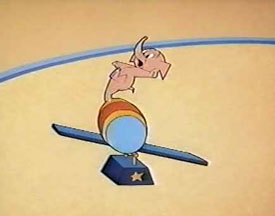 All this time, Jolly has been watching the act from just outside the tent, through a pair of large oversized eyeglasses. He is so moved emotionally by Ellsworth’s firing, that he begins to weep, and removes the eyeglasses to wring out from them a flood of tears. Ellsworth emerges slowly, his head drooping in shame, and Jolly calls to him to wait up. Seeing Ellsworth crying too, Jolly produces from a pocket a cloth the size of a large blanket, upon which is printed the word “Hanky”, and dries Ellsworth’s tears with it. Patting the elephant on the head, Jolly disappears off screen for an instant, returning with a new barrel for Ellsworth to stand on, and a small platform upon a pole, with a suction cup on the other end for Ellsworth to balance upon his head – with an idea for a new act. As Ellsworth assumes his position upon the barrel with the platform stuck to his head, Jolly climbs up onto the platform, carrying several oversized matchsticks and a huge firecracker. Once standing above, Jolly tells Ellsworth to begin barrel-rolling, while Jolly blindfolds himself. Jolly then balances the firecracker on his head, strikes the matches against his foot, and begins juggling the lighted matches in a circle around the firecracker. Intentionally, however, he allows the matches to descend into a tighter and tighter curve, until one of them makes contact with the fuse of the firecracker and ignites it. Jolly removes the blindfold, then squeaks to Ellsworth, “Okay, put me down.” Ellsworth obliges, lowering Jolly with his trunk to the ground. Jolly takes a bow to an imaginary audience, but Ellsworth panics when he sees the lit firecracker on Jolly’s head. Grabbing it with his trunk, he holds it out to Jolly, in body language that definitely suggests, “What do we do?” Calmly, Jolly reaches out, and plucks the wick out of the top of the firecracker – entirely removable – and holds it between his fingers until it reaches its end and poofs out, Jolly flipping away the last whiffs with a flourish of his fingers. Jolly then laughs, and shakes hands – that is, trunk – with Ellsworth, as the two form a new partnership.
All this time, Jolly has been watching the act from just outside the tent, through a pair of large oversized eyeglasses. He is so moved emotionally by Ellsworth’s firing, that he begins to weep, and removes the eyeglasses to wring out from them a flood of tears. Ellsworth emerges slowly, his head drooping in shame, and Jolly calls to him to wait up. Seeing Ellsworth crying too, Jolly produces from a pocket a cloth the size of a large blanket, upon which is printed the word “Hanky”, and dries Ellsworth’s tears with it. Patting the elephant on the head, Jolly disappears off screen for an instant, returning with a new barrel for Ellsworth to stand on, and a small platform upon a pole, with a suction cup on the other end for Ellsworth to balance upon his head – with an idea for a new act. As Ellsworth assumes his position upon the barrel with the platform stuck to his head, Jolly climbs up onto the platform, carrying several oversized matchsticks and a huge firecracker. Once standing above, Jolly tells Ellsworth to begin barrel-rolling, while Jolly blindfolds himself. Jolly then balances the firecracker on his head, strikes the matches against his foot, and begins juggling the lighted matches in a circle around the firecracker. Intentionally, however, he allows the matches to descend into a tighter and tighter curve, until one of them makes contact with the fuse of the firecracker and ignites it. Jolly removes the blindfold, then squeaks to Ellsworth, “Okay, put me down.” Ellsworth obliges, lowering Jolly with his trunk to the ground. Jolly takes a bow to an imaginary audience, but Ellsworth panics when he sees the lit firecracker on Jolly’s head. Grabbing it with his trunk, he holds it out to Jolly, in body language that definitely suggests, “What do we do?” Calmly, Jolly reaches out, and plucks the wick out of the top of the firecracker – entirely removable – and holds it between his fingers until it reaches its end and poofs out, Jolly flipping away the last whiffs with a flourish of his fingers. Jolly then laughs, and shakes hands – that is, trunk – with Ellsworth, as the two form a new partnership.
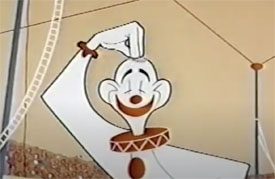 Inside, the ringmaster is in the process of introducing an acrobatic act, with several items of the team’s equipment already set up around the arena. Before he can even state the name of the performers, there is an uprising of laughter from the audience, as Ellsworth makes an unexpected appearance from the tent entrance with his barrel and platform, followed by a dancing, prancing Jolly. As Ellsworth rolls into one of the performance rings, the frustrated ringmaster advances upon him to throw him out again. However, Jolly slips up behind the ringmaster, attaching to his coattails a hook tied to a rope threaded through a pulley high upon one of the tent poles. Jolly pulls on the other end of the rope, hoisting the ringmaster to a position above one of the trapeze platforms high upon the pole, then ties off the rope end to the base of the pole, leaving the ringmaster stranded above, shouting for someone to get him down. Jolly then mounts Ellsworth’s platform, and begins his blindfolded juggling act. A new fuse in the firecracker is again ignited by the matches. But before Ellsworth can set Jolly down on the ground, he back-rolls his barrel into an unexpected obstacle – a teeterboard left by the acrobatic act, on one end of which rests a strongman’s barbell. Ellsworth falls from his barrel, landing on the opposite end of the teeterboard, and flips the barbell into the air, which collides with Jolly. Jolly is knocked to the other side of the ring, temporarily dazed, while the firecracker, still burning, lands in the center of the ring between them. Both Ellsworth and Jolly come to their senses, and react in shock takes at observing the ever-shortening fuse (Jolly’s take springs his bare feet out the bottoms of his oversize clown shoes). Ellsworth locates a broom resting against a tent pole, grabs it up with his trunk, and charges the firecracker in an attempt to snuff it out, while Jolly advances in the opposite direction. Ellsworth swats at the firecracker, but accidentally hits a trapeze release above with his broom instead. The trapeze catches Jolly under the chin and flips him upwards into the air, while the misdirected follow-through of Ellsworth’s swat flips the firecracker onto a trampoline. “They’re ruining the show”, moans the ringmaster from above, struggling to get his coat tail loose from the hook.
Inside, the ringmaster is in the process of introducing an acrobatic act, with several items of the team’s equipment already set up around the arena. Before he can even state the name of the performers, there is an uprising of laughter from the audience, as Ellsworth makes an unexpected appearance from the tent entrance with his barrel and platform, followed by a dancing, prancing Jolly. As Ellsworth rolls into one of the performance rings, the frustrated ringmaster advances upon him to throw him out again. However, Jolly slips up behind the ringmaster, attaching to his coattails a hook tied to a rope threaded through a pulley high upon one of the tent poles. Jolly pulls on the other end of the rope, hoisting the ringmaster to a position above one of the trapeze platforms high upon the pole, then ties off the rope end to the base of the pole, leaving the ringmaster stranded above, shouting for someone to get him down. Jolly then mounts Ellsworth’s platform, and begins his blindfolded juggling act. A new fuse in the firecracker is again ignited by the matches. But before Ellsworth can set Jolly down on the ground, he back-rolls his barrel into an unexpected obstacle – a teeterboard left by the acrobatic act, on one end of which rests a strongman’s barbell. Ellsworth falls from his barrel, landing on the opposite end of the teeterboard, and flips the barbell into the air, which collides with Jolly. Jolly is knocked to the other side of the ring, temporarily dazed, while the firecracker, still burning, lands in the center of the ring between them. Both Ellsworth and Jolly come to their senses, and react in shock takes at observing the ever-shortening fuse (Jolly’s take springs his bare feet out the bottoms of his oversize clown shoes). Ellsworth locates a broom resting against a tent pole, grabs it up with his trunk, and charges the firecracker in an attempt to snuff it out, while Jolly advances in the opposite direction. Ellsworth swats at the firecracker, but accidentally hits a trapeze release above with his broom instead. The trapeze catches Jolly under the chin and flips him upwards into the air, while the misdirected follow-through of Ellsworth’s swat flips the firecracker onto a trampoline. “They’re ruining the show”, moans the ringmaster from above, struggling to get his coat tail loose from the hook.
Ellsworth mounts the trampoline to take another swat at the wick, but Jolly also lands on the return swing of the trapeze right behind him, bouncing Ellsworth and the firecracker high into the air. Both collide with the bottom side of a trapeze platform above, and as Ellsworth falls, he discovers the firecracker has now compressed into and become firmly stuck inside his trunk. The poor elephant faints, while Jolly hastens to the rescue, positioning under Ellsworth a tall stack of acrobatic platforms, piled one on top of the other to a height of about one dozen. Ellsworth lands in a collapse on the top platform, while Jolly kicks away one platform after another from the stack to bring the elephant down one step at a time. The outraged ringmaster meanwhile finally gets his coat loose from the hook above, lands on the pole platform below him, and begins to climb his way back down to the ground. The final platform is kicked out from under Ellsworth, and Jolly at last gets a grip on the firecracker, extracts it from Ellsworth’s trunk, and does the remove-the-wick trick and finger flourish to prevent the explosion. The crowd erupts in ecstatic cheers and applause, but the ringmaster, arriving on the scene, is at first too angry to hear. Grabbing up both Jolly and Ellsworth, he shouts “You’re both fired!”, but then pauses, as the reaction of the crowd finally reaches his ears. Looking around the arena, the ringmaster realizes that the duo have in fact come up with a real crowd-pleaser, and his entire disposition changes, as he too joins in the applause. “Great act. Wonderful, wonderful. Bravo!”, he says in congratulations, all anger forgotten. No one, however, happens to notice that the firecracker, standing nearby, has this time had some fallout from the removed wick, and begins to smolder inside the wick hole. BOOOOM! When the smoke clears, the ringmaster is well blackened, with half of his outfit blasted away – yet, he continues to applaud the boys on their audience success, “Terrific act. The best yet!”, as the audience continues to applaud, and Ellsworth and Jolly, their future secured, take their final bows for the fade out.
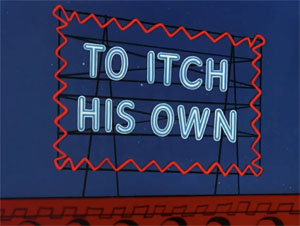 To Itch His Own (Warner, 6/28/58 – Chuck Jones, dir.) – At Norbert’s Flea Circus, we are introduced by poster art on the theatre wall to the “Mighty Angelo – World’s Strongest Flea”. He is depicted holing up a human-sized barbell with one finger, and in appearance and build is a classic human circus strong man (only colored green), in a one-piece outfit of tights held up by a single suspender, and with a huge Victorian-style handlebar moustache. Suddenly the stage door is knocked off its hinges from the inside, as a hopping dot emerges, and disappears down the alley, tossing trash cans a hundred times his size out of his way. Inside the theatre in the center ring rests a small cage with the bars bent from an apparent escape, and a miniature note to the management. “I’ve been working too hard so I’m going to take a rest on some nice quiet dog in the country…P.S. I’ll fix the door when I get back.” Finding a reasonably helpless looking dog on a country estate, Angelo applies the proper hold to the dog’s tail, and bends it into a staircase for himself to climb aboard. The dog starts to reflectively kick, but Angelo (demonstrating his signature gesture of untwirling the curls of his moustache into straight lines whenever he is peeved) merely stomps his foot, and flattens the dog out on his belly. Any attempt to scratch draws another stomp, until the dog, confused but observant, gets the message. A tough bulldog next door (Butcher) comes home with a bone, and decides to be a bully and make himself more comfortable, by booting the little dog off a small pillow and dragging the pillow back to his own yard. Having his rest disturbed, Angelo is peeved again. From a nearby brick wall, he loosems a brick, then drops it on the head of the bulldog, He not only steals back the pillow, but gives Butcher’s bone to the little dog (who still can’t see Angelo, and can’t figure where these gifts from nowhere are coming from).
To Itch His Own (Warner, 6/28/58 – Chuck Jones, dir.) – At Norbert’s Flea Circus, we are introduced by poster art on the theatre wall to the “Mighty Angelo – World’s Strongest Flea”. He is depicted holing up a human-sized barbell with one finger, and in appearance and build is a classic human circus strong man (only colored green), in a one-piece outfit of tights held up by a single suspender, and with a huge Victorian-style handlebar moustache. Suddenly the stage door is knocked off its hinges from the inside, as a hopping dot emerges, and disappears down the alley, tossing trash cans a hundred times his size out of his way. Inside the theatre in the center ring rests a small cage with the bars bent from an apparent escape, and a miniature note to the management. “I’ve been working too hard so I’m going to take a rest on some nice quiet dog in the country…P.S. I’ll fix the door when I get back.” Finding a reasonably helpless looking dog on a country estate, Angelo applies the proper hold to the dog’s tail, and bends it into a staircase for himself to climb aboard. The dog starts to reflectively kick, but Angelo (demonstrating his signature gesture of untwirling the curls of his moustache into straight lines whenever he is peeved) merely stomps his foot, and flattens the dog out on his belly. Any attempt to scratch draws another stomp, until the dog, confused but observant, gets the message. A tough bulldog next door (Butcher) comes home with a bone, and decides to be a bully and make himself more comfortable, by booting the little dog off a small pillow and dragging the pillow back to his own yard. Having his rest disturbed, Angelo is peeved again. From a nearby brick wall, he loosems a brick, then drops it on the head of the bulldog, He not only steals back the pillow, but gives Butcher’s bone to the little dog (who still can’t see Angelo, and can’t figure where these gifts from nowhere are coming from).
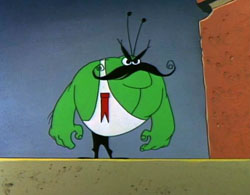 At the dog’s gate appears Butcher, tossing the brick up and down menacingly in one hand, ready for revenge. Angelo goes to work again, invisibly grabbing the bulldog’s tail, and dragging him bodily through a tiny knothole in the fence to his yard. The bulldog revives, and races toward the other dog’s yard. A sledge hammer rises out of a barrel of tools, seemingly under its own power, but with Angelo actually manipulating the handle, and clunks the bulldog soundly on the head, stopping him in his tracks. The dog picks up the hammer, but with Angelo still attached, and the object pounds him again repeatedly, then lands an underhanded blow amounting to the equivalent of a kick in the backside. The hammer pursues the dog across the yard on “foot”, cornering him in his doghouse. The dog sees stars, as Angelo’s blows reduce the doghouse to a heap of splinters. The bulldog produces from the rubble a bottle of “Old Dog-Nip”, and swears off on the spot, tossing the bottle away. A passing dog catcher’s wagon gives the bulldog a final idea. Grabbing the little dog, he props him up on top of a fence in the dogcatcher’s view, and whistles to call the official’s attention. A net is dropped on the little dog, to haul him in. But Angelo comes to the rescue again, smacking the dogcatcher in the seat of his pants with a two-by-four – then plants the board in the hands of the snickering bulldog. Guess who the dogcatcher drags off in his net? The little dog returns to his comfortable pillow, while a miniature TV aerial rises from the dog’s fur, as Angelo rests comfortably in a hammock strung between the dog’s hairs, watching an episode of “Glassie” (reference to the perennial “Lassie”) on a flea-sized portable TV.
At the dog’s gate appears Butcher, tossing the brick up and down menacingly in one hand, ready for revenge. Angelo goes to work again, invisibly grabbing the bulldog’s tail, and dragging him bodily through a tiny knothole in the fence to his yard. The bulldog revives, and races toward the other dog’s yard. A sledge hammer rises out of a barrel of tools, seemingly under its own power, but with Angelo actually manipulating the handle, and clunks the bulldog soundly on the head, stopping him in his tracks. The dog picks up the hammer, but with Angelo still attached, and the object pounds him again repeatedly, then lands an underhanded blow amounting to the equivalent of a kick in the backside. The hammer pursues the dog across the yard on “foot”, cornering him in his doghouse. The dog sees stars, as Angelo’s blows reduce the doghouse to a heap of splinters. The bulldog produces from the rubble a bottle of “Old Dog-Nip”, and swears off on the spot, tossing the bottle away. A passing dog catcher’s wagon gives the bulldog a final idea. Grabbing the little dog, he props him up on top of a fence in the dogcatcher’s view, and whistles to call the official’s attention. A net is dropped on the little dog, to haul him in. But Angelo comes to the rescue again, smacking the dogcatcher in the seat of his pants with a two-by-four – then plants the board in the hands of the snickering bulldog. Guess who the dogcatcher drags off in his net? The little dog returns to his comfortable pillow, while a miniature TV aerial rises from the dog’s fur, as Angelo rests comfortably in a hammock strung between the dog’s hairs, watching an episode of “Glassie” (reference to the perennial “Lassie”) on a flea-sized portable TV.
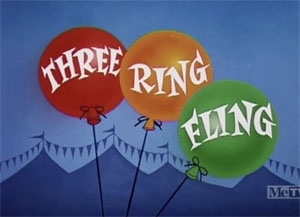 Three Ring Fling (Lantz/Universal, Windy and Breezy, 10/6/58 – Alex Lovy, dir.) – Windy and Breezy were a father and son team of bears, both voiced by Daws Butler, introduced by Lovy as supporting players in Woody Woodpecker’s “Fodder and Son”, then appearing solo in a handful of films of their own. One likely reason for their short career is that it quickly becomes obvious that Breezy has no personality, with all laughs stemming from blustery father Windy. It also feels as though the writers were already running shy on plot ideas during the series’ short progression, with the last two episodes feeling like carbon copies of a previous episode, on rather forced plot premises. “Three Ring Fling” is one of the best of the small bunch.
Three Ring Fling (Lantz/Universal, Windy and Breezy, 10/6/58 – Alex Lovy, dir.) – Windy and Breezy were a father and son team of bears, both voiced by Daws Butler, introduced by Lovy as supporting players in Woody Woodpecker’s “Fodder and Son”, then appearing solo in a handful of films of their own. One likely reason for their short career is that it quickly becomes obvious that Breezy has no personality, with all laughs stemming from blustery father Windy. It also feels as though the writers were already running shy on plot ideas during the series’ short progression, with the last two episodes feeling like carbon copies of a previous episode, on rather forced plot premises. “Three Ring Fling” is one of the best of the small bunch.
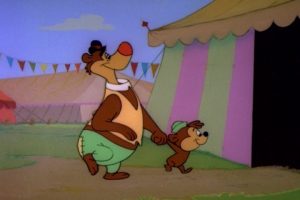 A circus has popped up on grounds below the bears’ hillside home. Breezy is excited, but also resigned to the fact that they will likely have to watch from a distance, as they have no money. But poppa Windy can only think of those yummy hot dogs, and vows they’re going to see the show, money or no money. When they reach the entrance, Breezy walks right in, as the circus is running a promotion of “Kids Admitted Free”. Not so easy for Windy, who quickly gets the boot – even when he reappears at the gate, with his fur combed like a juvenile’s haircut, trying to pass himself off as of minor age. A better chance for entry presents itself at the dressing tent of Bruno the Juggling Bear. (Any “coincidence” here that the bear’s name just happens to be the same as Bob McKimson’s memorable bear from “BigTop Bunny”?) Bruno is a dead ringer for Windy, except for the hat, as he snoozes on a sofa in the dressing tent. Windy slips inside, switching his own derby hat for Bruno’s circus fez. Then, he quickly wheels the sleeping Bruno’s sofa outside, into the back of a conveniently-located moving van, just as the van pulls away. The “new Bruno” chortles at what a soft position he has found his way into – until he receives a painful snap of a whip upon his rear end. It is time for Bruno’s act, and the ringmaster, with another snap of the whip, wraps Windy up in the whip leather like a well-tied Christmas present, and drags him inside.
A circus has popped up on grounds below the bears’ hillside home. Breezy is excited, but also resigned to the fact that they will likely have to watch from a distance, as they have no money. But poppa Windy can only think of those yummy hot dogs, and vows they’re going to see the show, money or no money. When they reach the entrance, Breezy walks right in, as the circus is running a promotion of “Kids Admitted Free”. Not so easy for Windy, who quickly gets the boot – even when he reappears at the gate, with his fur combed like a juvenile’s haircut, trying to pass himself off as of minor age. A better chance for entry presents itself at the dressing tent of Bruno the Juggling Bear. (Any “coincidence” here that the bear’s name just happens to be the same as Bob McKimson’s memorable bear from “BigTop Bunny”?) Bruno is a dead ringer for Windy, except for the hat, as he snoozes on a sofa in the dressing tent. Windy slips inside, switching his own derby hat for Bruno’s circus fez. Then, he quickly wheels the sleeping Bruno’s sofa outside, into the back of a conveniently-located moving van, just as the van pulls away. The “new Bruno” chortles at what a soft position he has found his way into – until he receives a painful snap of a whip upon his rear end. It is time for Bruno’s act, and the ringmaster, with another snap of the whip, wraps Windy up in the whip leather like a well-tied Christmas present, and drags him inside.
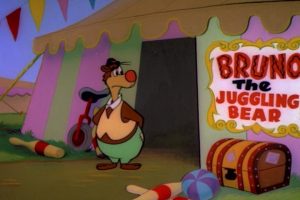 Bruno’s act is introduced to the audience, as the ringmaster tosses Windy three balls. Windy clumsily attempts to juggle them, but falls backwards onto a teeter-totter. At the other end of the board stands a human tower of acrobats, and the topmost performer leaps onto the other end of the board. Windy is propelled skyward, landing in a not-so-comfortable looking spread-eagle split upon the high wire. Suddenly a honking horn is heard, and a beautiful trapeze girl approaches Windy, riding a bicycle upon the wire at high speed. Windy is instantly smitten at her beauty, and, lapsing into a moment of gentlemanly chivalry, steps to one side off the wire to graciously bow and let the girl through. Of course, this means he is now standing on air, and Windy pays the price by taking a fall. He drops into the enclosure of an African lion. The lion, upon seeing Windy, immediately ties a bib around his own neck. Windy assumes he has dropped in just in time for lunch, ties on his own bib, and asks the lion what they’re having. The lion hands him a menu, with only one entry prominently displayed – Bear Burgers. Windy calmly unties his bib, hands it to the lion, then scoots with great haste under the bars of the enclosure, being momentarily compressed into impossible flatness. Running for any safe spot, Windy dives into a large wicker basket, which is immediately pulled to the center ring. It is the basket of a magician, who stands ready with a long sharp sword, as his shapely assistant also climbs into the basket and pulls a lid shut. A split-second later, the girl emerges with a scream, having apparently met up with Windy, while the magician plunges the sword into the side of the basket. Now Windy emerges with a scream, clutching his rear end, and zips out of frame. Windy lands on a unicycle, and is again tossed a set of juggling balls by the ringmaster. Concentrating on the balls, Windy allows his unicycle to roll backwards, into the act of a fire-eater, where Windy’s rear intercepts one of the flaming sticks the fire eater is about to consume. Windy does a shock-take, as steam emits from his ears.
Bruno’s act is introduced to the audience, as the ringmaster tosses Windy three balls. Windy clumsily attempts to juggle them, but falls backwards onto a teeter-totter. At the other end of the board stands a human tower of acrobats, and the topmost performer leaps onto the other end of the board. Windy is propelled skyward, landing in a not-so-comfortable looking spread-eagle split upon the high wire. Suddenly a honking horn is heard, and a beautiful trapeze girl approaches Windy, riding a bicycle upon the wire at high speed. Windy is instantly smitten at her beauty, and, lapsing into a moment of gentlemanly chivalry, steps to one side off the wire to graciously bow and let the girl through. Of course, this means he is now standing on air, and Windy pays the price by taking a fall. He drops into the enclosure of an African lion. The lion, upon seeing Windy, immediately ties a bib around his own neck. Windy assumes he has dropped in just in time for lunch, ties on his own bib, and asks the lion what they’re having. The lion hands him a menu, with only one entry prominently displayed – Bear Burgers. Windy calmly unties his bib, hands it to the lion, then scoots with great haste under the bars of the enclosure, being momentarily compressed into impossible flatness. Running for any safe spot, Windy dives into a large wicker basket, which is immediately pulled to the center ring. It is the basket of a magician, who stands ready with a long sharp sword, as his shapely assistant also climbs into the basket and pulls a lid shut. A split-second later, the girl emerges with a scream, having apparently met up with Windy, while the magician plunges the sword into the side of the basket. Now Windy emerges with a scream, clutching his rear end, and zips out of frame. Windy lands on a unicycle, and is again tossed a set of juggling balls by the ringmaster. Concentrating on the balls, Windy allows his unicycle to roll backwards, into the act of a fire-eater, where Windy’s rear intercepts one of the flaming sticks the fire eater is about to consume. Windy does a shock-take, as steam emits from his ears.
With another painful “YEOWTCH”, Windy is propelled forward, stopping just in front of the bandstand, where the cymbal player smashes his instruments together around Windy’s head, resulting in a typical compression gag for Windy’s skull. Nearly unconscious, Windy is carried in a slow roll out of the tent by his unicycle, his head landing through a hole in a canvas backdrop. He is now seen from the other side, the victim of a baseball-throwing booth where he is left to play the dodger. With the ringmaster looking for him again with whip in hand, Windy spits out a mouth full of baseballs, and hides in the rear of a large metal vehicle. The vehicle advances into the main tent, and turns out to be the mobile truck mount of the cannon for the human cannonball. Windy is fired – literally, and rides a real cannonball, hitting the tent roof and taking the big top with him, as he disappears over the horizon. The final scenes of the film find Windy sitting at the foot of a tree, one leg bound in bandages. Breezy, with a miniature whip, is behind him, attempting to train a squirrel to perform a juggling act. Windy will not watch his efforts, swearing that he never wants to see a circus again as long as he lives. Breezy cracks the whip, and poppa Windy finds that he now has an involuntary reflexive reaction to its sound. He immediately stands, grabbing the nearest three objects he can find (which happen to be rocks), and begins to juggle them, tossing them for a finish up into the air, then taking a bow. As he bends forward, the rocks each land on his head, the third one knocking him out cold. Breezy ends the film wondering what in the world in the matter with Pop, for the iris out.
The Animal Fair (Paramount/Famous, Noveltoon, 1/30/59 – Seymour Kneitel, dir.). is barely worth a mention, as it is a total cheater, possibly without a single frame of new animation, and only one modified background, being equally culled from two previous “Kartunes” (“Fun at the Fair” and “Philharmaniacs”) without the bouncing ball sequences. It repeats the trapeze act from “Fun at the Fair”, with the hippo dropping to her doom from the typical loose dentures.
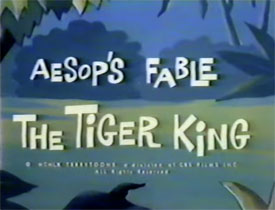 Aesop’s Fables: The Tiger King (Terrytoons/Fox, 3/1/60 – Connie Rasinski, dir.) – This, the last cartoon of the studio to fall back upon the banner name Terry had left behind when he departed Van Beuren, may rank as one of the worst-looking Terrytoons ever created. It feels like it was made without the participation of any in-betweeners, rendering most “motion” impossibly jerky and stilted. What drawings do appear lack effective posing to stand on their own, more like they were created with the intent to “glue” their random positions together by means of the rubbery-loose animation often characteristic of Jim Tyer – but Tyer does not seem to have made the gig, leaving the director’s key drawings feeling like they are substantially disjointed from one another. If the film looks this bad on the internet, one can only imaging how awful it must have looked on a Cinemascope screen.
Aesop’s Fables: The Tiger King (Terrytoons/Fox, 3/1/60 – Connie Rasinski, dir.) – This, the last cartoon of the studio to fall back upon the banner name Terry had left behind when he departed Van Beuren, may rank as one of the worst-looking Terrytoons ever created. It feels like it was made without the participation of any in-betweeners, rendering most “motion” impossibly jerky and stilted. What drawings do appear lack effective posing to stand on their own, more like they were created with the intent to “glue” their random positions together by means of the rubbery-loose animation often characteristic of Jim Tyer – but Tyer does not seem to have made the gig, leaving the director’s key drawings feeling like they are substantially disjointed from one another. If the film looks this bad on the internet, one can only imaging how awful it must have looked on a Cinemascope screen.
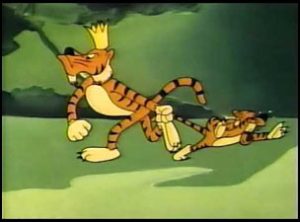 The story has a marginal connection to the theme topic of our present trail, as the lion, King of Beasts, packs a grip to leave his throne for the big city, and the bright lights of the Circus. The next-largest big cat, the Tiger, plays the opportunist and assumes the throne in the lion’s absence. The animals at first laugh at the thought of the Tiger playing king, but are scared away by the cat’s angry roar. The Tiger’s wife does not approve of the game either, and drags him off to handle mundane household chores, at least demonstrating that behind the scenes, she is the real ruler of the roost. Trouble begins to brew when the Tiger decides that his young cub should get some exposure to the kingdom’s subjects, over which he will be expected to rule someday. The Tiger thus enrolls his son in a jungle grammar school. However, as the narrator notes, Tiger cubs are known to get out of hand, and the teacher is soon demanding that the cub be removed from her classes. Mama Tiger asks whether he has been learning his lessons. The teacher explains that Junior is smart, and seems to grasp his lessons well – but there is a recurring problem in the schoolyard, as Junior goes off with one classmate or another, yet only Junior returns. Each time this happens, Junior seems to take on noticeable extra weight. The conclusion is obvious, and Mama puts the question to Junior whether he has been devouring classmates. Junior admits to the crimes – but claims he only ate a few. The King is astounded at the misbehavior of his son, but Mama seems to take it in stride as part of a Tiger’s nature to bite – and demonstrates it by herself taking a munch upon her mate’s ear. The King decides to hire an eagle and a monkey (the first for cunning, the second for similarity to man’s intelligence) as private tutors. Junior learns their special skills of pouncing in a graceful dive and swinging through trees, but when called upon to demonstrate his skills before the animals of the kingdom, is asked by Dad to introduce the tutors who taught him what he knows. Junior ponders how he can possibly do that, when they are both already inside of him. The body count in this violent cartoon, which seems like it would have been too much for most TV broadcasts to bear (possibly accounting for the title’s rarity) continues to mount, as Junior’s “recital” turns into a random rampage of devouring one animal after another. The King gives chase after his son, but just can’t get the kid under control. Finally, someone gets the bright idea to send a telegram to the lion in the bug city. Hearing of the panic in the jungle, the lion drops what he is doing in the middle of his act (snapping his jaws closed in the middle of a put-your-head-in-the-lion’s-mouth act, making it appear momentarily that he has bitten his trainer’s head off, although the trainer has merely retracted his head into his own collar like a turtle). The lion hops the first plane back to Africa, faces the Tiger, and promptly blackens his eye, taking back the crown to the cheers of the jungle animals. The film ends with the moral that you are what you are, and the tiger can’t change his stripes.
The story has a marginal connection to the theme topic of our present trail, as the lion, King of Beasts, packs a grip to leave his throne for the big city, and the bright lights of the Circus. The next-largest big cat, the Tiger, plays the opportunist and assumes the throne in the lion’s absence. The animals at first laugh at the thought of the Tiger playing king, but are scared away by the cat’s angry roar. The Tiger’s wife does not approve of the game either, and drags him off to handle mundane household chores, at least demonstrating that behind the scenes, she is the real ruler of the roost. Trouble begins to brew when the Tiger decides that his young cub should get some exposure to the kingdom’s subjects, over which he will be expected to rule someday. The Tiger thus enrolls his son in a jungle grammar school. However, as the narrator notes, Tiger cubs are known to get out of hand, and the teacher is soon demanding that the cub be removed from her classes. Mama Tiger asks whether he has been learning his lessons. The teacher explains that Junior is smart, and seems to grasp his lessons well – but there is a recurring problem in the schoolyard, as Junior goes off with one classmate or another, yet only Junior returns. Each time this happens, Junior seems to take on noticeable extra weight. The conclusion is obvious, and Mama puts the question to Junior whether he has been devouring classmates. Junior admits to the crimes – but claims he only ate a few. The King is astounded at the misbehavior of his son, but Mama seems to take it in stride as part of a Tiger’s nature to bite – and demonstrates it by herself taking a munch upon her mate’s ear. The King decides to hire an eagle and a monkey (the first for cunning, the second for similarity to man’s intelligence) as private tutors. Junior learns their special skills of pouncing in a graceful dive and swinging through trees, but when called upon to demonstrate his skills before the animals of the kingdom, is asked by Dad to introduce the tutors who taught him what he knows. Junior ponders how he can possibly do that, when they are both already inside of him. The body count in this violent cartoon, which seems like it would have been too much for most TV broadcasts to bear (possibly accounting for the title’s rarity) continues to mount, as Junior’s “recital” turns into a random rampage of devouring one animal after another. The King gives chase after his son, but just can’t get the kid under control. Finally, someone gets the bright idea to send a telegram to the lion in the bug city. Hearing of the panic in the jungle, the lion drops what he is doing in the middle of his act (snapping his jaws closed in the middle of a put-your-head-in-the-lion’s-mouth act, making it appear momentarily that he has bitten his trainer’s head off, although the trainer has merely retracted his head into his own collar like a turtle). The lion hops the first plane back to Africa, faces the Tiger, and promptly blackens his eye, taking back the crown to the cheers of the jungle animals. The film ends with the moral that you are what you are, and the tiger can’t change his stripes.
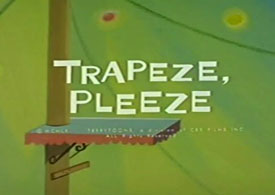 Trapeze, Pleeze (Terrutoons/Fox, Heckle and Jeckle, 7/1/60 – Connie Rasinski, dir.) – heckle and Jeckle have gone into a new line of work – a matrimonial agency. Some of their dialogue is well timed as they preside over a bank of phones and a rash of phone calls. Heckle answers one call. “You’ll make a dandy couple. Just mail us a check…”, then, turning angry, completing the conversation, “All right, we’ll sue!”, as he slams down the phone. Jeckle reads a new correspondence, in which a doting father offers $1,000 if they will find someone who will sign a contract to marry his daughter Thelda. The daughter is, however, a homely, giggling, clumsy hippopotamus. She appears at the front door, and the two magpies begin showing her photos of prospective bachelors. Thelda’s preference leads to one photo, which is apparently a publicity photo matching the pictorial banner of a performer appearing at the local circus – Dimwit, Dog of Daring Deeds. The magpies hurry off to the circus, confronting the dimwitted acrobat with fast sales talk, promising him the perfect mate if he’ll just sign on the dotted line. But one look at his prospective bride, and one crush within her embrace, and Dimwit is on the retreat. A fast-moving chase comedy ensues, with Heckle and Jeckle always right behind Thelda, ever-coaxing Dimwit to just set his signature to paper. Dimwit climbs to the relative safety of his trapeze act, but the magpies install springs between the trapeze bar and the ropes supporting it, causing the trapeze to stretch to the ground under his weight, right into the arms of Thelda. Thelda is propelled back ip to the high platforms by the springs, and waits on a platform while Dimwit dives for a net. H & J are right there at netside, to load Dimwit’s arms up with candy and flowers for Thelda on each bounce, as the hippo tries without success to grab Dimwit on each upward pass.
Trapeze, Pleeze (Terrutoons/Fox, Heckle and Jeckle, 7/1/60 – Connie Rasinski, dir.) – heckle and Jeckle have gone into a new line of work – a matrimonial agency. Some of their dialogue is well timed as they preside over a bank of phones and a rash of phone calls. Heckle answers one call. “You’ll make a dandy couple. Just mail us a check…”, then, turning angry, completing the conversation, “All right, we’ll sue!”, as he slams down the phone. Jeckle reads a new correspondence, in which a doting father offers $1,000 if they will find someone who will sign a contract to marry his daughter Thelda. The daughter is, however, a homely, giggling, clumsy hippopotamus. She appears at the front door, and the two magpies begin showing her photos of prospective bachelors. Thelda’s preference leads to one photo, which is apparently a publicity photo matching the pictorial banner of a performer appearing at the local circus – Dimwit, Dog of Daring Deeds. The magpies hurry off to the circus, confronting the dimwitted acrobat with fast sales talk, promising him the perfect mate if he’ll just sign on the dotted line. But one look at his prospective bride, and one crush within her embrace, and Dimwit is on the retreat. A fast-moving chase comedy ensues, with Heckle and Jeckle always right behind Thelda, ever-coaxing Dimwit to just set his signature to paper. Dimwit climbs to the relative safety of his trapeze act, but the magpies install springs between the trapeze bar and the ropes supporting it, causing the trapeze to stretch to the ground under his weight, right into the arms of Thelda. Thelda is propelled back ip to the high platforms by the springs, and waits on a platform while Dimwit dives for a net. H & J are right there at netside, to load Dimwit’s arms up with candy and flowers for Thelda on each bounce, as the hippo tries without success to grab Dimwit on each upward pass.
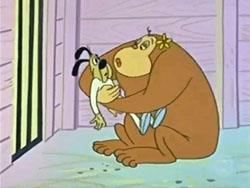 The two “lovers” wind up hanging from the high wire, while the magpies, realizing Dimwit is the “bashful type”, increase the height of one end of the wire, causing Dimwit to slide ever closer to Thelda. Dimwit leaps for a motorcycle on the ground, trying to speed to the tent exit, but one of the magpies Intercepts him with the muzzle of the human cannonball cannon, blasting Dimwit backwards toward Thelda’s waiting arms and puckered lips. Dimwit grabs a balloon vendor’s balloons, and floats to the top of the tent. “Cupid to the rescue”, shouts Heckle, producing a bow and a quiver of arrows. One by one, the balloons are popped by Heckle’s shots. Dimwit’s continued efforts to evade the altar include disguising as a clown, diving into a seal tank, and finally a death-defying leap from the heights of the tent without a net, blindfolded. All the way down, H & J maintain a chatter that it’s still not too late to sign, and Thelda continues unsuccessfully her attempts to catch and keep Dimwit in her arms. Dimwit lands with a crashing thud, and staggers wobbly. Suddenly, a little man in a red circus coat appears from the crowd. He announces himself as T. B. Barnyard, declaring Dimwirt’s feats the greatest comedy trapeze act he’s ever seen. He offers Dimwit passage on a departing steamship for bookings on a world tour, and a contract to sign to seal the deal. With Thelda approaching on the run from the rear again, the offer sounds quite appealing to Dimwit, and he hastily signs the paper, grabs the steamship ticket, and races up the gangplank at the nearby dock, with Thelda in hot pursuit. Heckle appears, now downtrodden and dejected. “Well, that did it. Now we’ll never get his signature, or the money.” ‘Did you say never, old bean?”, responds the English accent of Jeckle, as the “little man” removes a face mask to reveal the head of the magpie, holding the signed contract – for matrimony.
The two “lovers” wind up hanging from the high wire, while the magpies, realizing Dimwit is the “bashful type”, increase the height of one end of the wire, causing Dimwit to slide ever closer to Thelda. Dimwit leaps for a motorcycle on the ground, trying to speed to the tent exit, but one of the magpies Intercepts him with the muzzle of the human cannonball cannon, blasting Dimwit backwards toward Thelda’s waiting arms and puckered lips. Dimwit grabs a balloon vendor’s balloons, and floats to the top of the tent. “Cupid to the rescue”, shouts Heckle, producing a bow and a quiver of arrows. One by one, the balloons are popped by Heckle’s shots. Dimwit’s continued efforts to evade the altar include disguising as a clown, diving into a seal tank, and finally a death-defying leap from the heights of the tent without a net, blindfolded. All the way down, H & J maintain a chatter that it’s still not too late to sign, and Thelda continues unsuccessfully her attempts to catch and keep Dimwit in her arms. Dimwit lands with a crashing thud, and staggers wobbly. Suddenly, a little man in a red circus coat appears from the crowd. He announces himself as T. B. Barnyard, declaring Dimwirt’s feats the greatest comedy trapeze act he’s ever seen. He offers Dimwit passage on a departing steamship for bookings on a world tour, and a contract to sign to seal the deal. With Thelda approaching on the run from the rear again, the offer sounds quite appealing to Dimwit, and he hastily signs the paper, grabs the steamship ticket, and races up the gangplank at the nearby dock, with Thelda in hot pursuit. Heckle appears, now downtrodden and dejected. “Well, that did it. Now we’ll never get his signature, or the money.” ‘Did you say never, old bean?”, responds the English accent of Jeckle, as the “little man” removes a face mask to reveal the head of the magpie, holding the signed contract – for matrimony.
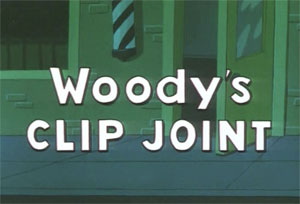 Woody’s Clip Joint (Lantz/Universal, Woody Woodpecker, 8/3/64 – Sid Marcus, dir.) – A late episode which is pretty well-done, obviously taking some inspiration from Woody’s 1940’s hit, “Barber of Seville”. Woody is having his topknot trimmed at a local barber shop, when the noon whistle blows. Barbers in this town must have a strong union, for the minute the whistle sounds, the barber hangs a sign on Woody’s beak reading “Out to lunch”, and departs the shop in mid-haircut, leaving Woody to sit and stew. However, it’s not going to be an uneventful hour. A police car speeding by draws Woody’s attention, and whirls him around in its wake like a whirlwind. A radio news bulletin suddenly broadcasts, that Wild King Louie the lion has escaped from the Bungling Brothers Circus. “Lock your doors. Lock your windows. HIDE!!”, yells the announcer. Woody follows the instruction, shutting all windows and barricading the door of the shop. But it doesn’t do much good, as a thumping at the door is followed by a powerful rush which pushes the door through all the boards Woody has hammered up, and off its hinges, as Louie the lion makes a hasty entrance into the shop, leaving Woody flattened between the loose door and the opposite wall. Woody alerts Louie of his presence by pecking his beak through the door and getting in a few pecks on the back of Louie’s head. Louie pulls him out, seizing him up in one paw. “Hide me, Woodpecker. They’re after me”, insists Louie. In a running gag, Louie demonstrates what Woody will get if he doesn’t cooperate, slapping him silly, and bopping him on the head. Woody seems ready to go along with it, and as the police car approaches again outside, Woody instructs Louie to sit in the barber’s chair, then hides Louie under a sheet. An armed officer enters the shop. “Did you see a lion around here?”, he asks. With the law present, Woody is now ready to turn traitor. “Did I see a lion? Oh, boy, I sure did! He’s right under….” Suddenly, a paw grabs Woody by the throat, yanking him under the sheet, and we see and hear movements under the sheet duplicating the slapping and bopping the lion had offered Woody previously. The paw replaces Woody outside the sheet, somewhat wobbly. “I didn’t see any lion, sir”, says Woody, changing his tune. “Are you sure?” asks the puzzled officer. “There’s nobody here”, responds Woody, giving the policeman a notable wink, as a high-sogn that he doesn’t mean what he says. The officer is slow to grasp, and as Woody tries to repeat the wink, Louie’s paw again emerges, delivering the bird another once-over below the sheet. When Woody re-emerges, his topknot shows visible signs of battering, and he weakly remarks. ‘Nobody here but us woodpeckers. Peck, peck, peck, peck, peck.” The dimwitted cop leaves empty-handed.
Woody’s Clip Joint (Lantz/Universal, Woody Woodpecker, 8/3/64 – Sid Marcus, dir.) – A late episode which is pretty well-done, obviously taking some inspiration from Woody’s 1940’s hit, “Barber of Seville”. Woody is having his topknot trimmed at a local barber shop, when the noon whistle blows. Barbers in this town must have a strong union, for the minute the whistle sounds, the barber hangs a sign on Woody’s beak reading “Out to lunch”, and departs the shop in mid-haircut, leaving Woody to sit and stew. However, it’s not going to be an uneventful hour. A police car speeding by draws Woody’s attention, and whirls him around in its wake like a whirlwind. A radio news bulletin suddenly broadcasts, that Wild King Louie the lion has escaped from the Bungling Brothers Circus. “Lock your doors. Lock your windows. HIDE!!”, yells the announcer. Woody follows the instruction, shutting all windows and barricading the door of the shop. But it doesn’t do much good, as a thumping at the door is followed by a powerful rush which pushes the door through all the boards Woody has hammered up, and off its hinges, as Louie the lion makes a hasty entrance into the shop, leaving Woody flattened between the loose door and the opposite wall. Woody alerts Louie of his presence by pecking his beak through the door and getting in a few pecks on the back of Louie’s head. Louie pulls him out, seizing him up in one paw. “Hide me, Woodpecker. They’re after me”, insists Louie. In a running gag, Louie demonstrates what Woody will get if he doesn’t cooperate, slapping him silly, and bopping him on the head. Woody seems ready to go along with it, and as the police car approaches again outside, Woody instructs Louie to sit in the barber’s chair, then hides Louie under a sheet. An armed officer enters the shop. “Did you see a lion around here?”, he asks. With the law present, Woody is now ready to turn traitor. “Did I see a lion? Oh, boy, I sure did! He’s right under….” Suddenly, a paw grabs Woody by the throat, yanking him under the sheet, and we see and hear movements under the sheet duplicating the slapping and bopping the lion had offered Woody previously. The paw replaces Woody outside the sheet, somewhat wobbly. “I didn’t see any lion, sir”, says Woody, changing his tune. “Are you sure?” asks the puzzled officer. “There’s nobody here”, responds Woody, giving the policeman a notable wink, as a high-sogn that he doesn’t mean what he says. The officer is slow to grasp, and as Woody tries to repeat the wink, Louie’s paw again emerges, delivering the bird another once-over below the sheet. When Woody re-emerges, his topknot shows visible signs of battering, and he weakly remarks. ‘Nobody here but us woodpeckers. Peck, peck, peck, peck, peck.” The dimwitted cop leaves empty-handed.
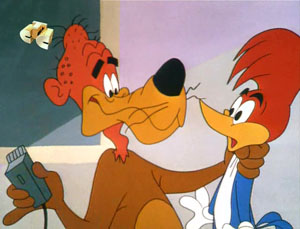 Louie emerges, warning Woody not to try that again, and demands to be hidden better. “Okay, but no more of this…and this”, says Woody, imitating the beatings he has been receiving upon Louie’s nose. “Okay, no more of this…and this” says Louie, demonstrating by giving Woody another beating. You can’t win for losing. So Woody turns to more forceful methods of retaliation. “This’ll hide you”, he calls out, as he flings a steaming hot towel onto Louie’s face. Louie is knocked backwards, toppling into the barber’s chair. The chair is equipped with telescoping lift apparatus, and with a pull of a lever, Woody elevates the chair to the ceiling, raising and lowering it to repeatedly smash Louie’s head into the ceiling panels. A more forceful elevation crashes Louie through the ceiling, and progressively upwards through suite after suite of the tall building upstairs, finally forcing Louie through the building’s roof and clear through a water tower on top. As the chair finally reaches its extension limit, Louie is seen out the roof of the tower, spitting out a fountain of water he has consumed while going through it. Woody now shifts the chair lever into reverse, causing the chair to plunge back through all the floors it has passed, at free-fall speed. Louie reaches ground level, and smashes through the floor into the basement. “While he’s out cold, I’m getting out fast”, says Woody to the audience. Woody scampers for the front door, but is halted in mid-air by the sound of the radio announcer, who delivers a new bulletin that a $1,000 reward has been offered for Louie’s capture. Greed is stronger than any instinct for safety, and Woody decides to stick around, hold Louie here, and claim the reward. Louie, on the other hand, is no longer in a mood to stay. Groggy from his chair ordeal, he attempts to find the exit, stating “I’ve had it. I’m a-gettin’ outta here.” Woody intercepts him at the doorway. “Wait! Don’t go out there. You’ll be recognized. I’ll give you a disguise.”
Louie emerges, warning Woody not to try that again, and demands to be hidden better. “Okay, but no more of this…and this”, says Woody, imitating the beatings he has been receiving upon Louie’s nose. “Okay, no more of this…and this” says Louie, demonstrating by giving Woody another beating. You can’t win for losing. So Woody turns to more forceful methods of retaliation. “This’ll hide you”, he calls out, as he flings a steaming hot towel onto Louie’s face. Louie is knocked backwards, toppling into the barber’s chair. The chair is equipped with telescoping lift apparatus, and with a pull of a lever, Woody elevates the chair to the ceiling, raising and lowering it to repeatedly smash Louie’s head into the ceiling panels. A more forceful elevation crashes Louie through the ceiling, and progressively upwards through suite after suite of the tall building upstairs, finally forcing Louie through the building’s roof and clear through a water tower on top. As the chair finally reaches its extension limit, Louie is seen out the roof of the tower, spitting out a fountain of water he has consumed while going through it. Woody now shifts the chair lever into reverse, causing the chair to plunge back through all the floors it has passed, at free-fall speed. Louie reaches ground level, and smashes through the floor into the basement. “While he’s out cold, I’m getting out fast”, says Woody to the audience. Woody scampers for the front door, but is halted in mid-air by the sound of the radio announcer, who delivers a new bulletin that a $1,000 reward has been offered for Louie’s capture. Greed is stronger than any instinct for safety, and Woody decides to stick around, hold Louie here, and claim the reward. Louie, on the other hand, is no longer in a mood to stay. Groggy from his chair ordeal, he attempts to find the exit, stating “I’ve had it. I’m a-gettin’ outta here.” Woody intercepts him at the doorway. “Wait! Don’t go out there. You’ll be recognized. I’ll give you a disguise.”
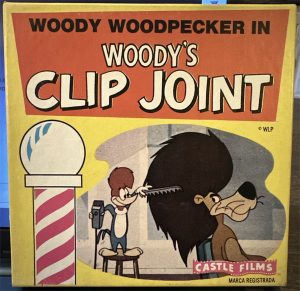 Woody beckons Louie back to another of the barber chairs, offering to start with a haircut. “Don’t take too much off the top”, requests the lion. “Leave it to me, Louie”, says Woody with a devilish grin, as he takes up a large electric hair trimmer. As the device whirs noisily, Woody sweeps with broad strokes across Louie’s mane, fur particles flying everywhere. When he is finished, he pauses to survey his work, as the camera pans to a full view of Louie, trimmed to a complete bald, revealing a bumpy, lopsided ugly scalp. Louie seems to be in a complete daze, as Woody takes one more stroke with the clippers to remove the last three or four stumps of fur remaining uncut. “Now for the disguise”, says Woody, mixing up a large glob of quick-dry mud pack, and flinging it to completely cover Louie’s face. Woody begins molding the mud as if he were a sculptor. In a matter of moments, he has reshaped Louie’s head to resemble a witch, then Frankenstein. Then, he twirls the mud around Louie’s neck, shaping it as if on a pottery wheel into a shape resembling a giant-sized version of a child’s top, which settles around Louie’s neck, as Louie’s head pops out from the top’s stem. “Perfect. Your own mother won’t recognize you”, says Woody. At this moment, a truck from the Bungling Brothers Circus pulls up outside, and the circus’s lion tamer enters, whip in hand. “Where is he? Where is that ferocious lion?” “Here, he is chief. He’s all yours. Hand over the $1,000 reward”, responds Woody. Louie is too worn out to resist, and stands ready to be captured, as the tamer passes Woody, without handing over the money, to examine the goods. One look at the disreputable shape Louie has been reduced to causes the tamer to stick out his tongue as if he is going to be sick to his stomach. “A thousand dollars? For THAT? You keep him. He’s all YOURS!” The tamer departs post-haste, ignoring Woody’s pleas to come back. As Woody nearly bursts into tears of frustration, the huge paw of Louie once again seizes him around the neck. Woody finds Louie now wielding the clippers, with a vengeful gleam in his eye. “Oh no, no, NOOO!”, wails Woody, in anticipation for the worst. The clippers buzz noisily again, as red feathers fly everywhere. As they stop, Louie is seen, laughing himself silly, as the camara pans to Woody, now shaved bald of his topknot feathers, revealing another lumpy, lopsided scalp. The defeated bird looks into a mirror to see the horrific result – and the mirror cracks from his ugliness. Woody attempts a feeble try at his closing laugh, but it develops into a pathetic whine, as we iris out.
Woody beckons Louie back to another of the barber chairs, offering to start with a haircut. “Don’t take too much off the top”, requests the lion. “Leave it to me, Louie”, says Woody with a devilish grin, as he takes up a large electric hair trimmer. As the device whirs noisily, Woody sweeps with broad strokes across Louie’s mane, fur particles flying everywhere. When he is finished, he pauses to survey his work, as the camera pans to a full view of Louie, trimmed to a complete bald, revealing a bumpy, lopsided ugly scalp. Louie seems to be in a complete daze, as Woody takes one more stroke with the clippers to remove the last three or four stumps of fur remaining uncut. “Now for the disguise”, says Woody, mixing up a large glob of quick-dry mud pack, and flinging it to completely cover Louie’s face. Woody begins molding the mud as if he were a sculptor. In a matter of moments, he has reshaped Louie’s head to resemble a witch, then Frankenstein. Then, he twirls the mud around Louie’s neck, shaping it as if on a pottery wheel into a shape resembling a giant-sized version of a child’s top, which settles around Louie’s neck, as Louie’s head pops out from the top’s stem. “Perfect. Your own mother won’t recognize you”, says Woody. At this moment, a truck from the Bungling Brothers Circus pulls up outside, and the circus’s lion tamer enters, whip in hand. “Where is he? Where is that ferocious lion?” “Here, he is chief. He’s all yours. Hand over the $1,000 reward”, responds Woody. Louie is too worn out to resist, and stands ready to be captured, as the tamer passes Woody, without handing over the money, to examine the goods. One look at the disreputable shape Louie has been reduced to causes the tamer to stick out his tongue as if he is going to be sick to his stomach. “A thousand dollars? For THAT? You keep him. He’s all YOURS!” The tamer departs post-haste, ignoring Woody’s pleas to come back. As Woody nearly bursts into tears of frustration, the huge paw of Louie once again seizes him around the neck. Woody finds Louie now wielding the clippers, with a vengeful gleam in his eye. “Oh no, no, NOOO!”, wails Woody, in anticipation for the worst. The clippers buzz noisily again, as red feathers fly everywhere. As they stop, Louie is seen, laughing himself silly, as the camara pans to Woody, now shaved bald of his topknot feathers, revealing another lumpy, lopsided scalp. The defeated bird looks into a mirror to see the horrific result – and the mirror cracks from his ugliness. Woody attempts a feeble try at his closing laugh, but it develops into a pathetic whine, as we iris out.
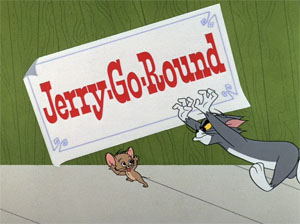 Jerry-Go-Round (Chuck Jones/MGM, Tom and Jerry, 3/3/66 – Abe Levitow, dir.) –
Jerry-Go-Round (Chuck Jones/MGM, Tom and Jerry, 3/3/66 – Abe Levitow, dir.) –
The cat and mouse are in one of their endless chases again, the titles creatively shown by pausing the action in the same manner as a Road Rinner cartoon to freeze the characters in mid-stride, long enough to read posted bills on a long fence behind them in the background. Tom comes out of the last freeze leaning a little too far over Jerry, and falls forward upon resumption of speed, taking a few somersaults. Jerry reverses direction, and approaches a poster on the fence for the Bungling Brothers’ Super-Colossal Circus, featuring a prominent head-shot of a lion with open, gaping jaws. Jerry takes a leap, seeming to disappear into the lion’s mouth. Tom doesn’t believe it, and tears away at the paper image where the mouth is depicted, revealing the flat fence behind the poster. However, the stunt was in fact possible, as there is a knothole in one board directly behind where the lion’s picture had appeared, and Jerry has simply slipped through the hole into the circus grounds. Jerry hides behind a tent stake as Tom passes him without noticing. As Jerry giggles, and turns away to leave, he is suddenly doused by a huge teardrop which falls from overhead. Towering over him is an elephant, crying, and making whimpering noises through its trunk like a weeping trumpet. Jerry soon spots the problem – a small tack, which has lodged itself into the underside of one of the mammoth’s front hoofs. Jerry slips under the elephant’s upraised foot, and gives a strong tug, pulling the tack loose. The elephant spots Jerry, and rears back in fear at the sight of a mouse, as all elephants are prone to do. Tom catches up at just this moment, and, being the nearest thing handy, is picked up by the elephant’s trunk to use as a defensive weapon. Repeating a gag which we’ve seen from “Acrobatty Bunny”, the elephant whacks at Jerry with Tom, whomping the cat several times across a platform, and leaving him in a temporary daze. Jerry brings the elephant up to speed on the situation, by showing her the tack that he removed. When the elephant realizes her foot is no longer in pain, she picks up Jerry gently in her trunk, and nuzzles him affectionately against her face, her trunk making soft sounds ranging between a purr and a coo. Tom recovers long enough to rase a ladder to the elephant’s face, attempting to snatch Jerry away. The elephant grabs Jerry back, then clenches the tip of her trunk into the shape of a fist, bashing Tom on the head, and driving the ladder and Tom down until they stand within a crater in the ground, no more than three rungs visible above surface level. Tom stumbles out of the hole, then falls flat.
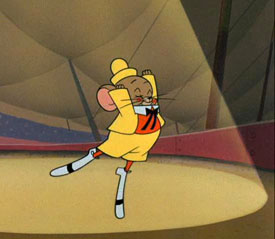 The scene changes to the evening show. A new performer has been added to the cast – Jerry, in full clown outfit. He executes a smoothly-animated dance, then engages in more terpsichore with the elephant, who also appears in clown hat, and plays a game of ballet-style toss with Jerry, using a large ball. Tom, hiding behind a platform, produces a slingshot, and with dead aim explodes the inflated ball while it is in Jerry’s hands. The distressed elephant looks desperately about the rubber remnants of the ball for signs of Jerry, not noticing that the force of the explosion has sent Jerry aloft, leaving him stranded on the high wire. Tom clims a ladder to a platform at one end of the wire, and steps out to reach Jerry. With well-timed jumps upon the wire, Tom bounces Jerry closer and closer to him, until Jerry is within his grasp. But who should also walk out onto the wire but the elephant, whose weight instantly stretches the wire so that all three of them are back at ground level. Sucking with her trunk, the elephant vacuums Jerry out of the hold of Tom’s paw. Then, the elephant merely steps off the wire, repeating Junyer Bear’s act in “Bear Feat”, allowing the wire to spring back to normal height, and launch Tom through the tent roof. A fade out, and Jerry is next seen scrambling up a ladder to a high-diving platform. Tom follows, and the two both dive toward a water tank below. Jerry safely plunges in first. The elephant suddenly appears, sucking up all the water so she can retrieve Jerry and take him fondly away. Tom hits the empty metal tank with such force, that he is driven through the magma of the Earth, eventually returning to the surface by way of the unseen sounds of an elevator, and deposited back on the surface by the end of the pitchfork of the Devil himself.
The scene changes to the evening show. A new performer has been added to the cast – Jerry, in full clown outfit. He executes a smoothly-animated dance, then engages in more terpsichore with the elephant, who also appears in clown hat, and plays a game of ballet-style toss with Jerry, using a large ball. Tom, hiding behind a platform, produces a slingshot, and with dead aim explodes the inflated ball while it is in Jerry’s hands. The distressed elephant looks desperately about the rubber remnants of the ball for signs of Jerry, not noticing that the force of the explosion has sent Jerry aloft, leaving him stranded on the high wire. Tom clims a ladder to a platform at one end of the wire, and steps out to reach Jerry. With well-timed jumps upon the wire, Tom bounces Jerry closer and closer to him, until Jerry is within his grasp. But who should also walk out onto the wire but the elephant, whose weight instantly stretches the wire so that all three of them are back at ground level. Sucking with her trunk, the elephant vacuums Jerry out of the hold of Tom’s paw. Then, the elephant merely steps off the wire, repeating Junyer Bear’s act in “Bear Feat”, allowing the wire to spring back to normal height, and launch Tom through the tent roof. A fade out, and Jerry is next seen scrambling up a ladder to a high-diving platform. Tom follows, and the two both dive toward a water tank below. Jerry safely plunges in first. The elephant suddenly appears, sucking up all the water so she can retrieve Jerry and take him fondly away. Tom hits the empty metal tank with such force, that he is driven through the magma of the Earth, eventually returning to the surface by way of the unseen sounds of an elevator, and deposited back on the surface by the end of the pitchfork of the Devil himself.
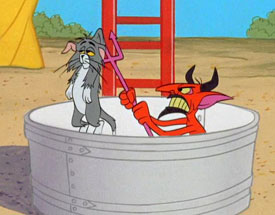 The elephant plays a game of blow-and-catch with Jerry, blowing him gently into the air with her trunk, then catching him again with her suction. Tom tries a cruel trick, tying to a long pole and positioning over her head a large pepper shaker, depositing the inflammatory powder into the elephant’s sinus cavity. The elephant begins to inhale for a mighty sneeze, the suction drawing in the walls and roof of the circus tent as if by an interior vacuum. Tom meanwhile waits outside with a catcher’s mitt, as the elephant’s sneeze blasts Jerry out of the same hole in the tent roof created by Tom. Tom backs up, and up, to make the catch, until he finds himself climbing up the legs and face of the elephant, who has somehow outrun him to appear behind him. The elephant seizes Tom in her trunk, rolls the trunk up like a kiddie birthday-party blower, then extends her trunk to full length with a powerful blow, ejecting Tom from the scene, while the catcher’s mitt falls upon the tip of her trunk, allowing her to neatly catch Jerry and provide him with cuddling once again. The final black-out gag shows Jerry participating in a circus parade, playing cymbals atop a drum ahead of the marching elephant. Tom waits ahead at a manhole, placing in the street a dynamite stick and plunger-trigger, directly in the elephant’s path. Before retreating to the safety of the manhole, Tom fails to notice the wires connected to the dynamite vibrating from the elephant’s stomps and curling up, pulling the dunamite stick back, and into the open manhole. Tom dives in, and pulls the manhole cover shut, just as the elephant steps heavily upon the plunger. BOOM goes the manhole, and as the elephant passes, a white flag appears out one of the holes of the lid, with letters on it reading “The End”, as the elephant kicks dirt upon the manhole as a final gesture of disdain, for the iris out.
The elephant plays a game of blow-and-catch with Jerry, blowing him gently into the air with her trunk, then catching him again with her suction. Tom tries a cruel trick, tying to a long pole and positioning over her head a large pepper shaker, depositing the inflammatory powder into the elephant’s sinus cavity. The elephant begins to inhale for a mighty sneeze, the suction drawing in the walls and roof of the circus tent as if by an interior vacuum. Tom meanwhile waits outside with a catcher’s mitt, as the elephant’s sneeze blasts Jerry out of the same hole in the tent roof created by Tom. Tom backs up, and up, to make the catch, until he finds himself climbing up the legs and face of the elephant, who has somehow outrun him to appear behind him. The elephant seizes Tom in her trunk, rolls the trunk up like a kiddie birthday-party blower, then extends her trunk to full length with a powerful blow, ejecting Tom from the scene, while the catcher’s mitt falls upon the tip of her trunk, allowing her to neatly catch Jerry and provide him with cuddling once again. The final black-out gag shows Jerry participating in a circus parade, playing cymbals atop a drum ahead of the marching elephant. Tom waits ahead at a manhole, placing in the street a dynamite stick and plunger-trigger, directly in the elephant’s path. Before retreating to the safety of the manhole, Tom fails to notice the wires connected to the dynamite vibrating from the elephant’s stomps and curling up, pulling the dunamite stick back, and into the open manhole. Tom dives in, and pulls the manhole cover shut, just as the elephant steps heavily upon the plunger. BOOM goes the manhole, and as the elephant passes, a white flag appears out one of the holes of the lid, with letters on it reading “The End”, as the elephant kicks dirt upon the manhole as a final gesture of disdain, for the iris out.
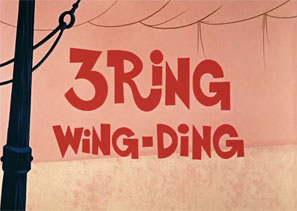 3 Ring Wing-Ding (Warner Bros. 7 Arts, Cool Cat, 8/24/68 – Alex Lovy, dir.) – Director Lovy tries to recapture some of the spirit of “Three Ring Fling” about a decade later. While he delivers a lot of action, the gag material seems old and tired, and misfires about as often as the shots of Colonel Rimfire. Rimfire spots a newspaper ad offering a reward of $1,000 for delivery of a live tiger to the circus. Rimfire envisions getting rid of Cool Cat and becoming rich at the same time. At gunpoint, he confronts the Cat while the feline sleeps lazily in a hammock. Cool Cat feigns willingness to accompany the Colonel, but instead slams down the hammock over his pursuer. The chase is on, and Cool Cat just happens to run right onto the circus grounds. He dives under the tent flaps, but ducks as a roustabout attempts to whack him with a stick to keep him from entering without admission. The next head under the canvas is Rimfire’s, and the Colonel takes the blow, while Cool Cat sneaks in unseen behind the roustabout. Cool hides inside a snake charmer’s basket (a variation reminiscent of the basket-hiding sequence of Windy bear), while the Colonel is delayed, having to purchase a ticket. As the snake charmer begins to play a flute, Cool is betrayed by his own tail, which rises from the basket to wiggle a dance to the flute’s music. Cool receives a shot from the Colonel, in the seat of his pants through the basket. Cool runs toward a canvas sheet with a hole cut in it, and grabs a can of paint and brush to invite the Colonel to the hole, painting above it the word “Look”. Of course, when Rimfire peeks through it, he is pelted with baseballs by Cool Cat on the other side (another setup lifted from “Three Ring Fling”). Short spot gags follow, with Cool briefly impersonating a seal in a horn act, then bouncing the Colonel through the roof from a teeter-totter, forcing him to buy a second ticket to regain entry to the show.
3 Ring Wing-Ding (Warner Bros. 7 Arts, Cool Cat, 8/24/68 – Alex Lovy, dir.) – Director Lovy tries to recapture some of the spirit of “Three Ring Fling” about a decade later. While he delivers a lot of action, the gag material seems old and tired, and misfires about as often as the shots of Colonel Rimfire. Rimfire spots a newspaper ad offering a reward of $1,000 for delivery of a live tiger to the circus. Rimfire envisions getting rid of Cool Cat and becoming rich at the same time. At gunpoint, he confronts the Cat while the feline sleeps lazily in a hammock. Cool Cat feigns willingness to accompany the Colonel, but instead slams down the hammock over his pursuer. The chase is on, and Cool Cat just happens to run right onto the circus grounds. He dives under the tent flaps, but ducks as a roustabout attempts to whack him with a stick to keep him from entering without admission. The next head under the canvas is Rimfire’s, and the Colonel takes the blow, while Cool Cat sneaks in unseen behind the roustabout. Cool hides inside a snake charmer’s basket (a variation reminiscent of the basket-hiding sequence of Windy bear), while the Colonel is delayed, having to purchase a ticket. As the snake charmer begins to play a flute, Cool is betrayed by his own tail, which rises from the basket to wiggle a dance to the flute’s music. Cool receives a shot from the Colonel, in the seat of his pants through the basket. Cool runs toward a canvas sheet with a hole cut in it, and grabs a can of paint and brush to invite the Colonel to the hole, painting above it the word “Look”. Of course, when Rimfire peeks through it, he is pelted with baseballs by Cool Cat on the other side (another setup lifted from “Three Ring Fling”). Short spot gags follow, with Cool briefly impersonating a seal in a horn act, then bouncing the Colonel through the roof from a teeter-totter, forcing him to buy a second ticket to regain entry to the show.
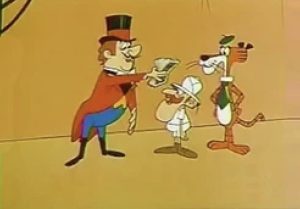 Cool Cat impersonates Asbesto, the Fire Eater. Essentially, we repeat Sylvester’s gag from “Tweety’s Circus”, as Rimfire insists Cool Cat prove it by performing the act. Steam pours out of Cool Cat’s ears (another lift from “Three Ring Fling”), and Cool runs for a box marked “In case of fire, break glass”. In a surprise result from breaking the glass, a pair of human hands emerges from the box, drenching Cool Cat with a toss of a bucket of water. Cool next dodges Rimfire’s bullets by leaping to the high wire, and stepping out onto it, carrying a small umbrella for balance. Rimfire approaches from the opposite direction, riding a bicycle upon the wire. “It’s a one-way street, Cool Cat, and you’re going the wrong way.” The Colonel’s shots blast away the umbrella, and Cool Cat is forced to skedaddle back to the platform behind him on all fours. But Rimfire never reaches him, as Cool Cat cuts the wire, sending the Colonel into a fall, landing atop the popes of a calliope, upon which he bounces from pipe to pipe with the playing of each note. A strong puff of steam makes the Colonel airborne again, and he takes to a trapeze, clenching his rifle between his teeth as he swings. Cool Cat swings from a trapeze in the opposite direction, flying through the air in a triple somersault, and grabbing onto the Colonel’s legs. Cool falls, as the Colonel’s pants come off. The Colonel modestly attempts to hide his boxer shorts, letting go of the trapeze bar, then plummets. He lands in a large watering pail for the elephants, as one pachyderm (couldn’t they at least come up with a new character design for the elephant, rather than make the live beast look like a twin to the robot vehicle Ella that Rimfire had used for transportation in previous episodes?) grabs him with its trunk and tosses the Colonel away. Catching a tentpole with one arm for a double twirl around the pole, the Colonel again falls from a dizzy height. But Cool Cat mercifully waits below, catching the Colonel safely in his own pair of lost trousers. The ringmaster applauds, calling the act stupendous, and hires them both on the spot, at a salary of $500 a week in advance. The satisfied Colonel graciously suggests to Cool Cat that they divide the salary. Cool Cat insists on doing the dividing, and begins the standard crooked method of counting. “One for you and one for me, Two for you and one, two, for me…” And so on.
Cool Cat impersonates Asbesto, the Fire Eater. Essentially, we repeat Sylvester’s gag from “Tweety’s Circus”, as Rimfire insists Cool Cat prove it by performing the act. Steam pours out of Cool Cat’s ears (another lift from “Three Ring Fling”), and Cool runs for a box marked “In case of fire, break glass”. In a surprise result from breaking the glass, a pair of human hands emerges from the box, drenching Cool Cat with a toss of a bucket of water. Cool next dodges Rimfire’s bullets by leaping to the high wire, and stepping out onto it, carrying a small umbrella for balance. Rimfire approaches from the opposite direction, riding a bicycle upon the wire. “It’s a one-way street, Cool Cat, and you’re going the wrong way.” The Colonel’s shots blast away the umbrella, and Cool Cat is forced to skedaddle back to the platform behind him on all fours. But Rimfire never reaches him, as Cool Cat cuts the wire, sending the Colonel into a fall, landing atop the popes of a calliope, upon which he bounces from pipe to pipe with the playing of each note. A strong puff of steam makes the Colonel airborne again, and he takes to a trapeze, clenching his rifle between his teeth as he swings. Cool Cat swings from a trapeze in the opposite direction, flying through the air in a triple somersault, and grabbing onto the Colonel’s legs. Cool falls, as the Colonel’s pants come off. The Colonel modestly attempts to hide his boxer shorts, letting go of the trapeze bar, then plummets. He lands in a large watering pail for the elephants, as one pachyderm (couldn’t they at least come up with a new character design for the elephant, rather than make the live beast look like a twin to the robot vehicle Ella that Rimfire had used for transportation in previous episodes?) grabs him with its trunk and tosses the Colonel away. Catching a tentpole with one arm for a double twirl around the pole, the Colonel again falls from a dizzy height. But Cool Cat mercifully waits below, catching the Colonel safely in his own pair of lost trousers. The ringmaster applauds, calling the act stupendous, and hires them both on the spot, at a salary of $500 a week in advance. The satisfied Colonel graciously suggests to Cool Cat that they divide the salary. Cool Cat insists on doing the dividing, and begins the standard crooked method of counting. “One for you and one for me, Two for you and one, two, for me…” And so on.
A few even later theatricals, then on into television, next time.


 Charles Gardner is an animation enthusiast who toils by day as a member of LA Law – but by nights and weekends indulges in classic jazz and ragtime as a performer; and studies classic Hollywood cartoons… maybe a little too much.
Charles Gardner is an animation enthusiast who toils by day as a member of LA Law – but by nights and weekends indulges in classic jazz and ragtime as a performer; and studies classic Hollywood cartoons… maybe a little too much.


































































































































































So many interesting cartoons here. I especially liked the heckle and Jekyll and the clown cartoon that started this entire post. Even though we’re getting into “limited“ or stylized animation, the plots are still fun.
“French Fried” sounds like a wonderfully entertaining cartoon, to judge from your description of it, and I’m not surprised that it was the hit of the festival. I hope I have a chance to see it sooner rather than later.
I’ve commented elsewhere that the dour, balding, bespectacled man sitting in the front row of the audience in “Jolly the Clown” looks like Famous Studios director Izzy Sparber, who, if not exactly humourless, was by all accounts not a real barrel of monkeys to be around — going off by himself to do paperwork in the middle of the company Christmas party, that sort of thing. By 1957 Izzy had lost his job in one of those periodic mass layoffs that made working at Famous so exciting, so he would not have been around to take umbrage at the homage.
Personally I think “The Tiger King” is far from one of the worst-looking Terrytoons ever created, even though certain scenes appear to have been animated on fours or sixes. It’s one of those cartoons with a jungle setting inhabited by animals from disparate continents, and in my book it gets extra points for having giant anteaters in it. Little by little I’m putting an Animation Trail of giant anteater cartoons together in my spare time. So far there’s not enough of them to make a Part 2.
And, there is “Big Top Bunny,” where Bugs deals with Bruno the Magnificent. This circus bear has a super-sized ego and comes complete with a Russian accent.
Gardner already covered “Big Top Bunny” a few weeks ago.
I wish there had been more Windy & Breezy cartoons, feeling they were definitely better than The Beary Family shorts, which went on forever. Always loved Daws Butler’s “Ralph Kramden” voice and I like Windy’s general colorful appearance (derby, vest, patched pants). My introduction to Windy & Breezy was 50 years ago when I bought a Super 8 cartoon called Salmon Yeggs starring “Pierre Bear”. The coonskin wearing bruin pictured on the film box looked nothing like Windy, of course. That little film was also my first glimpse of the “Inspector Willoghby” character, here playing a fish factory guard. I didn’t see that entire Windy & Breezy short (with sound and color) till much more recently, thanks to either YouTube or a Walter Lantz DVD set (I forget which).
The animation of “Tiger King” actually is an interesting alternative to the limbs-and-mouth-on-separate-cels limited animation that had become prevalent by 1960: mostly full body movement, just fewer in-betweens. It’s still a pretty nasty cartoon, though. Considering Terrytoon standards at the best of times, it’s not as much of a come-down as “3 Ring Wing-Ding” (the Warner Bros.-7 Arts cartoons look and sound more like Jay Ward rejects than real Warner Bros. cartoons).
The reason “The Tiger King” looks rather poor is probably because the short might have begun production before Gene Deitch briefly took over the studio (with a smaller budget) and had the short shelved. When he was let go, producer Bill Weiss must’ve decided to rescue the short and have it finished despite the now limited budget.
I have to disagree with you about Jim Tyer not having “made the gig”. His animation is clear and present in the scenes where characters move in a fluid, rubbery manner, and especially the scene in which the newly crowned tiger has his vision of staying king for perpetuity. However, the issue with the occasional jauntiness of the animation due to a potential lack of inbetweening is understandable, and it seems most noticeable during scenes of dialogue when the narrator quotes each character as they gesture verbally.
Additionally (as Nic points out), this short does appear as if it had been shelved for some time. I’d wager that production on this short may have likely started sometime during the early to mid-50’s, seeing as the only animators who appear to have worked on this short are Tyer and Carlo Vinci. Having been released in 1960, at a time when Terrytoons’ budget had already been scaled back substantially, Weiss must have found himself in such a tight spot that he felt he had no choice but to get it done without fussing over any missing details that would have made a difference in quality at the risk of running up a tab for the studio and further delay it’s long-overdue release.
Btw, I’m curious as to who the narrator is in this short. He sounds like one of those familiar veteran voices who’ve provided narration for industrial and educational films.
“Hamilton the Musical Elephant” (Halas and Batchelor, 1961 — John Halas, dir.), not to be confused with “Hamilton: the Musical”, concerns the titular pachyderm, the world’s smallest yet most forgetful circus elephant, whose greatest joy in life is playing trumpet on his trunk. The ringmaster tries in vain to teach Hamilton to balance on a ball, jump through a hoop, ride a unicycle, and so on, taking much longer than you’d think necessary to realise that a trumpet-playing elephant would make a much more popular circus attraction than one that could merely do those mundane tricks. In the sequel, “Hamilton in the Music Festival”, which uses much of the same animation and music from the previous cartoon, Hamilton leaves the circus and jams with some zany beatniks at a jazz festival.
Two more from Paramount-
“Cock-a-doodle-Dino”,(12/6/57, Noveltoon rebranded Harveytoons,dir.I.Sparer,wri.Larz Bourne)
the classic,sweeet,mother hen-raising her own-dino short with the hen teaching her dino, Danny*, how to peck like a chicken, only for him to be captured for the circus, miss his family, and be asked by a shrink exactly whenn did he feeel like a chicken (Dann:(Makes Chicken clucks..)..meanwhile, the hen, not to be stopped, sees the news clipping on her new adopted son, runs to the circus, and just after weeping, gets the dino-mother of all greetings by Danny, causing the peeking-in ringmaster to sign them all to a new permanent circus conract.
*Like in Syd Hoff’s Danny and the Dinosaur.
“The Kid From Mars” (later 1960; Modern Madcap/Kosmo;dir.Seymour Kneil,wri:Jack Mercer and Carl Meyer)
the first followup to (after a year),”Out of this Whirl” finds a heavily redesigned Kosmo, the martian kid from that episode, in his new Big Top exploits. First, he zaps a juggler’s bowling pins that he uses, then runs into a W.C.Fields wananabe ringmaster, who follows him around, He then zaps to non-existence a circus elephant’s cage. Next he disrupts a strongman and several others till he’s chased by W.C.Ringmaster up the tightwqire and some tumbling occurs and thye land. The audience applauds! The ringmaster thusly signs Kosmo only to find he has zoomed into space!
Both shorts’, like many Famous/Harvey/Parmount/King Features’biggest strength is Winston Sharples’s quite iconic later stock music,with the storiesjust as distinctive.